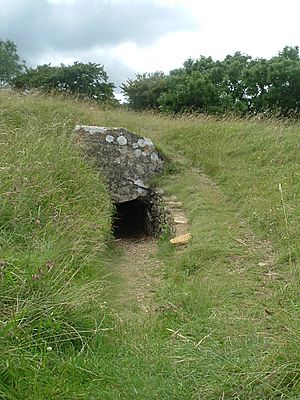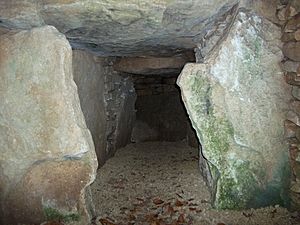Uley Long Barrow facts for kids
Quick facts for kids Uley Long Barrow |
|
|---|---|

The entrance to Uley Long Barrow
|
|
| Type | Transepted gallery grave |
| Location | Uley |
| OS grid reference | SO 78953 00034 |
| Area | Gloucestershire |
| Built | Prior to 3000 BCE |
| Owner | English Heritage |
| Official name: Uley long barrow, also known as Hetty Pegler`s Tump, 400m south-east of Knapp Farm House | |
| Designated | 21 October 1921 |
| Reference no. | 1008195 |
| Lua error in Module:Location_map at line 420: attempt to index field 'wikibase' (a nil value). | |
Uley Long Barrow is an ancient burial mound in Gloucestershire, England. It is also known as Hetty Pegler's Tump. This special place was built a very long time ago, even before 3000 BC. That means it's over 5,000 years old!
Contents
What is Uley Long Barrow?
Uley Long Barrow is a type of ancient tomb. It is often called a "long barrow" because of its shape. But it's actually a specific kind of tomb called a "transepted gallery grave." This means it has a central passage with rooms branching off it.
This huge mound was built by people living in the Neolithic period. This was a time when people first started farming and building permanent homes.
Inside the Barrow
The mound is about 37 meters (121 feet) long. It is also about 34 meters (112 feet) wide. At its highest point, it reaches about 3 meters (10 feet) tall.
Inside, there's a passage made of stone. This passage leads to several chambers. There are two rooms on each side of the passage. Another room is found at the very end. The whole mound is held together by a wall made of dry stone. This wall helps to keep the earth in place.
Discoveries at the Barrow
People have explored Uley Long Barrow many times. The first major archaeological dig happened in 1821. During this dig, archaeologists found the remains of fifteen skeletons. This tells us that many people were buried here long ago.
Later, they found another burial. This one was from the Roman age, which was much later than when the barrow was built. It was placed above one of the chambers. Another excavation took place in 1854 to learn even more.
The Name Hetty Pegler's Tump
The local nickname for the barrow is "Hetty Pegler's Tump." A "tump" is an old word for a small hill or mound. The name comes from Hester Pegler, who lived in the 1600s. She was the wife of Henry Pegler, a landowner in the area. Hester died in 1694, and Henry died in 1695.
Visiting the Barrow
Uley Long Barrow is easy to find. It is clearly marked from Crawley Hill (the B4066 road). This road runs between the villages of Uley and Nympsfield. The barrow is about 1.4 kilometers (0.9 miles) south of another ancient site, Nympsfield Long Barrow.
In 2011, the barrow was temporarily closed. This was for important safety work. After the work was finished, it was reopened for visitors to explore again.


